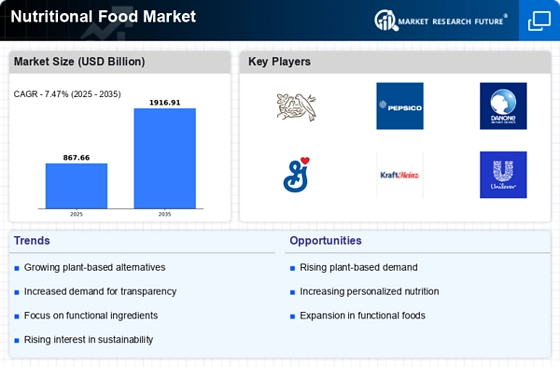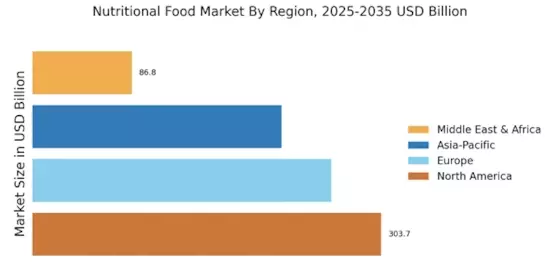Increased Health Awareness
The Nutritional Food Market is experiencing a notable surge in consumer health consciousness. Individuals are increasingly prioritizing their well-being, leading to a heightened demand for foods that offer health benefits. This trend is reflected in the market data, which indicates that the health and wellness food segment is projected to grow at a compound annual growth rate of approximately 8% over the next five years. Consumers are actively seeking products that are rich in nutrients, low in artificial additives, and beneficial for overall health. This shift in consumer behavior is compelling manufacturers to innovate and reformulate their offerings to align with health-oriented preferences, thereby driving growth within the Nutritional Food Market.
Rising Demand for Functional Foods
The Nutritional Food Market is witnessing a significant increase in the demand for functional foods, which are designed to provide health benefits beyond basic nutrition. This trend is largely driven by consumers' desire for products that can enhance their health and prevent diseases. Market data suggests that the functional food segment is expected to reach a valuation of over 300 billion dollars by 2026. These foods often contain added ingredients such as probiotics, vitamins, and minerals, which appeal to health-conscious consumers. As awareness of the benefits of functional foods continues to grow, manufacturers are likely to invest in research and development to create innovative products that cater to this burgeoning demand, thus propelling the Nutritional Food Market forward.
Growth of E-commerce in Food Retail
The rise of e-commerce is transforming the Nutritional Food Market, as more consumers turn to online platforms for their grocery shopping. This shift is driven by the convenience and accessibility that online shopping offers, particularly for health-oriented products. Market data indicates that online grocery sales are expected to grow by over 20% annually, reflecting a significant change in consumer purchasing behavior. E-commerce platforms are increasingly featuring a wide range of nutritional foods, allowing consumers to easily compare products and access detailed information about their nutritional content. As online shopping becomes more prevalent, companies in the Nutritional Food Market are likely to enhance their digital presence and invest in online marketing strategies to capture this growing segment of consumers.
Sustainability and Ethical Sourcing
Sustainability has emerged as a pivotal driver within the Nutritional Food Market, as consumers increasingly favor products that are ethically sourced and environmentally friendly. This trend is reflected in the growing popularity of organic and sustainably produced foods, which are perceived as healthier options. Market data indicates that the organic food market is projected to grow at a rate of 10% annually, highlighting the shift towards sustainable consumption. Companies are responding by adopting sustainable practices in their supply chains, which not only appeals to eco-conscious consumers but also enhances brand loyalty. As sustainability becomes a core value for many consumers, the Nutritional Food Market is likely to see continued growth in this area, with an emphasis on transparency and ethical sourcing.
Technological Advancements in Food Production
Technological innovations are playing a crucial role in shaping the Nutritional Food Market. Advances in food processing, preservation, and packaging technologies are enabling manufacturers to enhance the nutritional profile of their products while extending shelf life. For instance, the use of high-pressure processing and freeze-drying techniques allows for the retention of nutrients in food products. Market data suggests that the food technology sector is expected to grow significantly, with investments in food tech projected to exceed 100 billion dollars by 2027. These advancements not only improve product quality but also cater to the evolving preferences of health-conscious consumers. As technology continues to evolve, the Nutritional Food Market is likely to benefit from increased efficiency and innovation.


















Leave a Comment